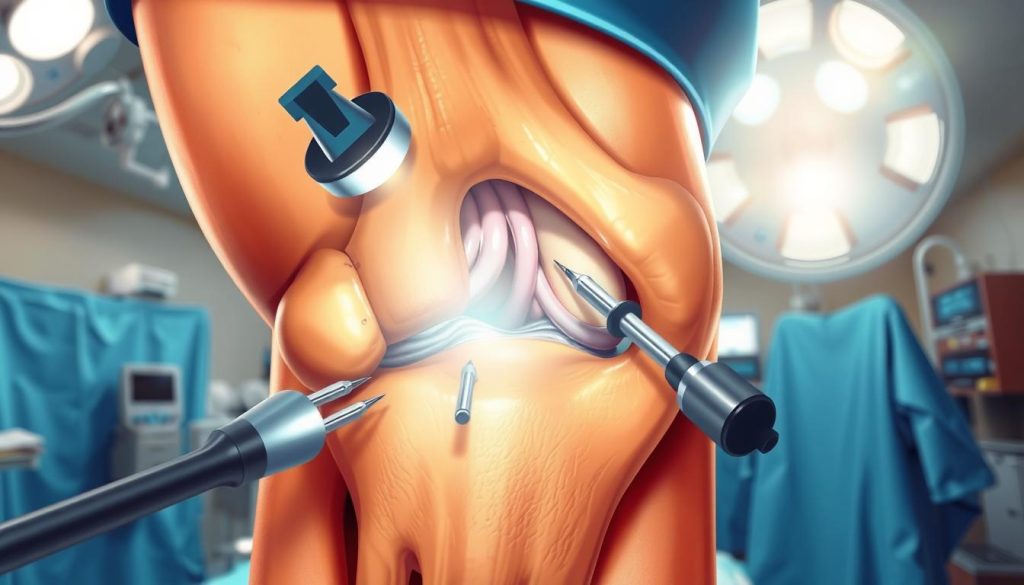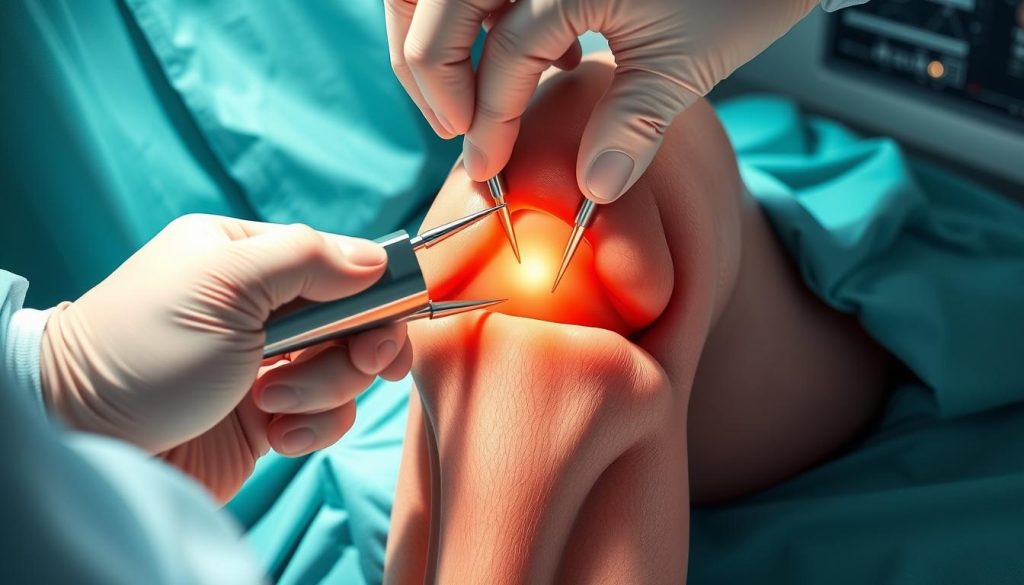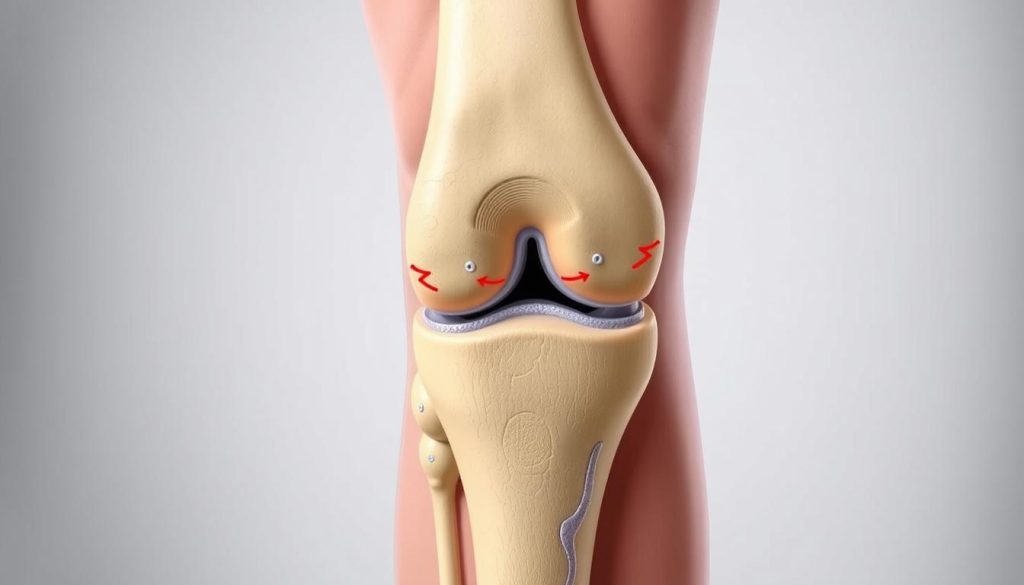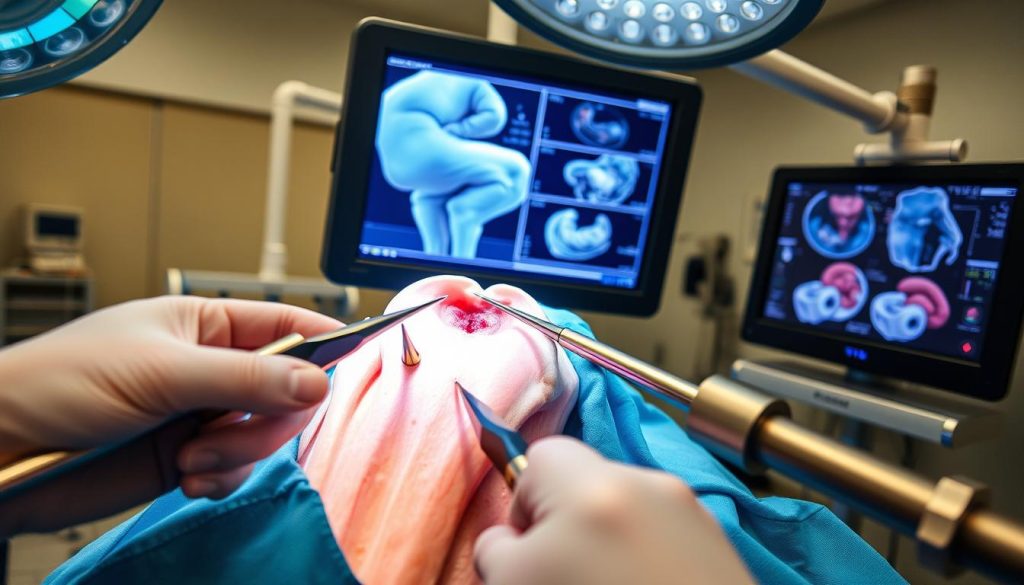Arthroscopic surgery for the knee has changed orthopedics a lot. It’s a small procedure that lets doctors fix many knee problems with great accuracy. They use small cuts and special tools to do this, causing less damage to the tissue.
People who get this surgery usually feel less pain and heal faster than with old-school surgeries. This method also means less scarring and fewer chances of serious problems. So, more and more people and doctors are choosing arthroscopic surgery for their knees.
Arthroscopic surgery can fix many knee issues, like torn meniscus or ligament repairs. It helps people get back to their normal lives quicker and with better results. This shows how useful arthroscopic surgery is in today’s orthopedic care.
Understanding Arthroscopic Surgery Knee Procedures
Knee arthroscopy has changed orthopedic surgery for the better. It offers a less invasive way to treat knee problems. This method lets surgeons diagnose and treat with more precision and less damage.
History and Development of Knee Arthroscopy
The history of knee arthroscopy goes back to the early 20th century. It started as a way to look inside the knee and grew into a treatment method by the 1970s. Now, knee arthroscopy is key in modern orthopedic surgery. It lets doctors fix complex knee issues through small cuts.
Basic Principles and Techniques
Knee arthroscopy uses a small camera (arthroscope) inserted through tiny cuts. This lets surgeons see inside the knee on a screen and fix problems with special tools. They often do:
- Meniscus repair or removal
- Ligament reconstruction
- Removing loose cartilage or bone fragments
- Treating knee arthritis
Advanced Technology in Modern Arthroscopy
New tech in arthroscopy has made surgeries better. High-definition cameras give clearer views, and computer systems help with precision. These tools help surgeons do more complex jobs with less harm to tissues.

The ongoing improvement in knee arthroscopy is a big win for orthopedic surgery. Patients get to recover faster, feel less pain, and have better results than with old surgery methods.
Common Conditions Treated with Knee Arthroscopy
Knee arthroscopy is a key procedure for diagnosing and treating knee problems. It’s a minimally invasive method that lets surgeons fix common knee injuries with great accuracy. This approach causes less damage to the surrounding tissues.

A torn meniscus is a common reason for knee arthroscopy. This injury often happens during sports or when the knee twists suddenly. People with a torn meniscus may feel pain, swelling, and have trouble moving their knee. Arthroscopic surgery can fix or trim the damaged meniscus, helping the knee work better.
ACL repair is another common procedure done through arthroscopy. The ACL can tear during intense activities, leading to instability and pain. Surgeons use small incisions to rebuild the ACL, helping patients get back to their active lives.
Cartilage damage is also treated with knee arthroscopy. This can come from wear and tear or sudden injury. The procedure removes damaged cartilage and encourages new growth. This reduces pain and improves joint function.
| Condition | Symptoms | Arthroscopic Treatment |
|---|---|---|
| Torn Meniscus | Pain, swelling, locking sensation | Trimming or repair of damaged tissue |
| ACL Tear | Instability, pain during pivoting | Ligament reconstruction |
| Cartilage Damage | Joint pain, stiffness, swelling | Debridement, microfracture |
Other conditions treated with knee arthroscopy include synovitis, loose bodies, and certain fractures. Early treatment with these minimally invasive methods can help patients avoid bigger surgeries. They also get to recover faster.
Benefits of Minimally Invasive Knee Surgery
Minimally invasive knee surgery is a big step forward in orthopedics. It offers better results and quicker healing times compared to old methods.
Reduced Recovery Time and Pain
Arthroscopic knee surgery is a minimally invasive method. It leads to faster healing and less pain after surgery. People can get back to their daily lives in weeks, not months.
Lower Risk of Complications
With smaller cuts, the risk of infection and scarring goes down. There’s also less blood loss and damage to nerves or blood vessels. This makes the surgery safer for more people, even those with health issues.
Improved Surgical Precision
Advanced imaging helps surgeons see and fix knee problems accurately. This precision leads to better results and long-term health for patients.
| Benefit | Traditional Knee Surgery | Minimally Invasive Knee Surgery |
|---|---|---|
| Incision Size | 8-10 inches | 0.5-1 inch |
| Hospital Stay | 3-5 days | Outpatient or 1 day |
| Recovery Time | 2-3 months | 2-6 weeks |
| Scarring | Significant | Minimal |
Minimally invasive knee surgery is a great choice for many. It reduces pain, speeds up recovery, and improves accuracy. This method is changing orthopedic care for the better.
Preparing for Your Knee Arthroscopy Procedure
Getting ready for arthroscopic surgery on your knee is a big step. Your doctor will check if you’re ready for the surgery. This might include blood tests, physical exams, and imaging studies.
Changing your medications is key before knee surgery. Some drugs can make bleeding more likely. Your surgeon might tell you to stop taking them. Always listen to your doctor about changing medications.

Making lifestyle changes can help your surgery go well. Quit smoking, eat healthy, and stay active but not too hard. These steps can help you recover faster and avoid problems.
- Arrange transportation to and from the surgical center
- Prepare your home for post-surgery recovery
- Pack comfortable clothes and necessary personal items
- Follow fasting guidelines provided by your surgeon
On the day of your surgery, get to the center on time. Bring your ID, insurance, and any medical papers you need. Wear loose clothes that are easy to take off and put back on.
| Time Before Surgery | Action |
|---|---|
| 2 weeks | Stop smoking and alcohol consumption |
| 1 week | Discontinue blood-thinning medications |
| Night before | Shower with antibacterial soap |
| 8 hours before | Stop eating solid foods |
| 2 hours before | Stop drinking clear liquids |
By following these steps, you’ll be ready for your knee arthroscopy. This will help make your surgery and recovery go smoothly.
The Step-by-Step Surgical Process
Knee arthroscopy is a detailed orthopedic surgery that needs skill and precision. Knowing the steps can make patients feel more comfortable before their surgery.
Anesthesia Administration
The first step is giving anesthesia. Patients might get local, regional, or general anesthesia. Local anesthesia numbs just the knee. Regional anesthesia numbs the whole leg. General anesthesia makes the patient sleep during surgery.
Surgical Entry Points
After anesthesia, the surgeon makes small cuts around the knee. These small openings, called portals, let the arthroscope and tools in. Usually, two to three portals are made, each as small as a buttonhole.

Intraoperative Procedures
With the arthroscope in, the surgeon sees the knee joint on a screen. This clear view helps guide the surgery. They might:
- Remove or fix torn cartilage
- Fix torn ligaments
- Take out loose bone or cartilage pieces
- Treat knee infections
The surgeon uses special tools through these small cuts. This method is key to knee arthroscopy. It causes less damage and leads to quicker healing than open surgery.
| Procedure | Average Duration | Recovery Time |
|---|---|---|
| Meniscus Repair | 30-45 minutes | 4-6 weeks |
| ACL Reconstruction | 60-90 minutes | 6-9 months |
| Cartilage Debridement | 20-30 minutes | 2-4 weeks |
Recovery and Rehabilitation Timeline
After knee surgery, patients start a journey to get back to normal. They work on regaining function and easing joint pain. The recovery has different stages, each showing progress towards full recovery.
In the first week, managing pain and swelling is key. Patients use ice packs and follow their medication plans. They also use crutches or a walker for limited movement.
Weeks two to four are about slowly getting more mobile. Physical therapy starts, with gentle exercises to improve movement. Patients may start to put weight on the knee, based on their doctor’s advice.
The next one to three months bring big changes. Most people go back to their daily routines and work, with some job limits. Exercises get stronger, and joint pain starts to lessen.
| Recovery Phase | Activities | Pain Level |
|---|---|---|
| 0-1 Week | Rest, ice, elevation | Moderate to high |
| 2-4 Weeks | Light exercises, limited walking | Moderate, decreasing |
| 1-3 Months | Increased activity, strengthening | Mild, intermittent |
| 3-6 Months | Return to most activities | Minimal to none |
By six months, many can do all their usual activities, even sports. Full recovery might take a year, with ongoing strength and endurance gains. Regular check-ups with the surgeon help ensure healing during the rehab journey.
Physical Therapy After Arthroscopic Knee Surgery
Physical therapy is very important after knee surgery. It helps patients get their strength and flexibility back. This is true for those who had surgery because of an injury or other issues.
Early Stage Exercises
In the beginning, patients do gentle exercises. These help with healing and prevent stiffness. Some examples are:
- Ankle pumps to improve circulation
- Quad sets to engage thigh muscles
- Heel slides for knee flexion
- Straight leg raises to strengthen hip muscles
Progressive Rehabilitation Protocol
As healing gets better, exercises get harder. This stage might include:
- Weight-bearing activities
- Balance and proprioception training
- Strength training for surrounding muscle groups
- Range of motion exercises
Return to Activity Guidelines
The last part of rehab is getting ready for normal activities. Guidelines are:
- Gradual return to low-impact activities
- Sport-specific training for athletes
- Functional testing to ensure readiness
- Continued strengthening and flexibility exercises
Having a personalized physical therapy plan is essential for recovery. Patients should work with their healthcare providers for safe and effective rehab.
Potential Risks and Complications
Arthroscopic knee surgery is generally safe but comes with risks. People thinking about this surgery should know about possible problems. Arthroscopic knee procedures have a high success rate. But, it’s important to understand the risks to make an informed choice.
- Infection at incision sites
- Blood clots in leg veins
- Nerve or blood vessel damage
- Persistent swelling or stiffness
- Allergic reactions to anesthesia
Some complications are less common but can vary by procedure. These might include cartilage damage, broken instruments, or deep vein thrombosis.
| Complication | Frequency | Management |
|---|---|---|
| Infection | Less than 1% | Antibiotics, wound care |
| Blood clots | 1-2% | Blood thinners, compression stockings |
| Nerve damage | 0.1-1.7% | Physical therapy, nerve repair surgery |
Even with risks, the benefits of arthroscopic knee surgery often outweigh them for most. Choosing an experienced surgeon and following post-op advice can lower the chance of problems.
Success Rates and Expected Outcomes
Knee arthroscopy is a common treatment for joint pain. Let’s look at the numbers and what patients can expect after this procedure.
Statistical Analysis of Results
Studies show knee arthroscopy works well for many patients. A recent review found success rates between 70% and 90%. This depends on the specific condition treated.
| Condition | Success Rate | Pain Reduction |
|---|---|---|
| Meniscus Tears | 85% | 70% |
| ACL Reconstruction | 90% | 80% |
| Cartilage Repair | 75% | 60% |
Long-term Prognosis
The long-term outlook for knee arthroscopy is good. Most patients see a big drop in joint pain and better function. Outcomes depend on age, health, and how well you follow up with physical therapy.
Even though knee arthroscopy often brings lasting relief, some might need more treatments later. Regular check-ups with your doctor are key. They help keep track of your progress and tackle any new issues quickly.
“Knee arthroscopy has revolutionized how we treat joint problems, providing quicker recovery and better results than traditional surgeries.”
Cost and Insurance Considerations
Arthroscopic knee surgery is often cheaper than open surgery. The cost can change based on several things. These include the surgeon’s experience, hospital fees, and where you live.
Insurance for arthroscopic knee surgery varies. Many plans cover it if it’s needed. It’s important to check with your insurance about what they cover. Ask questions like:
- Is pre-authorization required?
- What percentage of the surgery cost will be covered?
- Are there any out-of-pocket expenses?
- Is physical therapy covered post-surgery?
If you don’t have insurance or have high deductibles, many hospitals offer payment plans. Some surgeons give discounts for those paying out of pocket. Looking into these options can help make knee surgery more affordable.
| Expense Category | Estimated Cost Range |
|---|---|
| Surgeon’s Fee | $1,500 – $3,000 |
| Anesthesia | $600 – $1,200 |
| Facility Fee | $2,000 – $5,000 |
| Post-Op Care | $500 – $1,500 |
Keep in mind, these costs are just estimates. They can change. Always talk about costs with your healthcare provider and insurance before getting arthroscopic knee surgery.
Comparing Traditional vs. Arthroscopic Knee Surgery
Knee surgery has changed a lot over time. The choice between open surgery and arthroscopic procedures depends on the condition and patient needs. Let’s look at the main differences between these methods.
Surgical Approaches
Traditional knee surgery uses a big incision, showing the whole joint. Arthroscopic knee surgery, on the other hand, is a small incision method with a camera. This way, it causes less damage and scarring.
Recovery Differences
The recovery time is different for each method. Arthroscopic surgery often means:
- Shorter hospital stays
- Less post-operative pain
- Quicker return to daily activities
Traditional surgery takes longer to heal and needs more rehab.
Cost Comparisons
Arthroscopic procedures might seem pricier at first, but they can save money in the long run. Here are some points to consider:
| Factor | Traditional Surgery | Arthroscopic Surgery |
|---|---|---|
| Initial Procedure Cost | Lower | Higher |
| Hospital Stay | 3-5 days | 0-1 day |
| Time Off Work | 4-6 weeks | 1-2 weeks |
| Physical Therapy Duration | 3-6 months | 1-3 months |
The choice between traditional and arthroscopic knee surgery depends on the condition, patient health, and surgeon’s skill. While arthroscopy has many benefits, some complex cases might need traditional surgery.
Latest Innovations in Knee Arthroscopy
Knee arthroscopy is getting better, giving patients new ways to fix knee problems. New tech in orthopedic surgery is making surgeries more precise and better for patients.
3D imaging systems are changing knee arthroscopy. They give surgeons a clear, 3D view of the knee. This helps them find and fix problems more accurately.
Robotic-assisted arthroscopy is another big step. It lets surgeons do detailed work with great precision. This means patients can heal faster and have better results.
New ways to fix damaged tissues are also exciting. These methods help keep the knee working well and reduce future problems. It’s a big change in how we treat knee issues.
| Innovation | Benefits | Impact on Recovery |
|---|---|---|
| 3D Imaging Systems | Enhanced visualization | Improved accuracy, fewer complications |
| Robotic-Assisted Arthroscopy | Increased precision | Faster recovery, less tissue damage |
| Advanced Tissue Repair | Tissue preservation | Better long-term joint function |
Biological treatments like PRP and stem cell therapy are becoming popular. They use the body’s healing powers to fix tissues and reduce swelling. This could mean lasting relief for many patients.
Choosing the Right Orthopedic Surgeon
Finding the best orthopedic surgeon for your knee surgery is key. Look for a board-certified specialist with lots of experience in arthroscopic procedures. Check their credentials, success rates, and how many similar operations they’ve done.
Good communication is essential. A top surgeon will take the time to explain the procedure and answer your questions. They should make you feel comfortable and confident about your surgery. Trust your gut when meeting surgeons.
Doing your research is important. Read patient reviews and ask your primary care doctor for recommendations. If you’re unsure, don’t hesitate to get a second opinion. Remember, feeling comfortable with your surgeon can greatly impact your surgery and recovery.
By carefully choosing your orthopedic surgeon, you’re setting yourself up for a successful knee arthroscopy. Take your time, ask questions, and find a professional who meets your needs and expectations.
FAQ
Q: What is arthroscopic knee surgery?
A: Arthroscopic knee surgery is a minimally invasive procedure. It uses a small camera and special tools to diagnose and treat knee problems. Small incisions are made in the knee to view and work inside without opening it fully.
Q: What conditions can be treated with knee arthroscopy?
A: Knee arthroscopy can treat several conditions. These include torn meniscus, ACL injuries, cartilage damage, loose bodies in the joint, and certain types of arthritis. It’s great for repairing or removing damaged tissue and addressing inflammation.
Q: How long does recovery from arthroscopic knee surgery take?
A: Recovery time varies based on the procedure and individual factors. Patients usually can get back to normal activities in 6-8 weeks. But, athletes might need several months to fully recover. Following your surgeon’s and physical therapist’s advice is key for a good recovery.
Q: Is arthroscopic knee surgery painful?
A: Some discomfort is expected, but it’s usually less than with traditional open surgery. Pain management techniques, like medication and physical therapy, help reduce discomfort during recovery.
Q: What are the risks associated with knee arthroscopy?
A: While generally safe, risks include infection, blood clots, nerve or blood vessel damage, and anesthesia complications. These risks are low, and your surgeon will discuss them with you before the procedure.
Q: How soon can I walk after arthroscopic knee surgery?
A: Many patients can walk with crutches or a walker right after surgery. Walking unassisted can take a few days to a couple of weeks, depending on the procedure and your surgeon’s advice.
Q: Will I need physical therapy after knee arthroscopy?
A: Yes, physical therapy is a must for recovery. It helps restore strength, flexibility, and function to your knee. Your surgeon will give you a rehabilitation plan tailored to your needs and the procedure.
Q: How successful is arthroscopic knee surgery?
A: Success rates for arthroscopic knee surgery are high, with many patients seeing big improvements in joint pain and function. But, outcomes can vary based on the condition treated, the patient’s health, and following post-operative care.
Q: Is arthroscopic knee surgery covered by insurance?
A: Many insurance plans cover arthroscopic knee surgery when it’s medically necessary. But, coverage can vary by policy and reason for the procedure. It’s important to check with your insurance about coverage and any out-of-pocket costs.
Q: How do I choose the right orthopedic surgeon for my knee arthroscopy?
A: When choosing a surgeon, look at their experience with knee arthroscopy, board certification, and patient reviews. Choose a surgeon who communicates well, explains the procedure clearly, and makes you feel at ease. Don’t be afraid to ask about their success rates and experience with similar procedures.


















